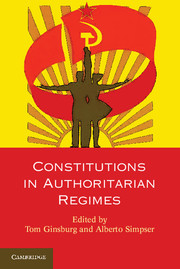Book contents
- Frontmatter
- Contents
- List of Contributors
- 1 Introduction
- Part I The Category
- Part II Constitutional Design in Authoritarian Regimes
- 4 The Political Economy of Autocratic Constitutions
- 5 Authoritarian Constitution Making
- 6 Constitutions in Authoritarian Regimes
- Part III Contents of Authoritarian Constitutions
- Part IV Consequences of Authoritarian Constitutions
- Index
- References
5 - Authoritarian Constitution Making
The Role of the Military in Latin America*
Published online by Cambridge University Press: 05 June 2014
- Frontmatter
- Contents
- List of Contributors
- 1 Introduction
- Part I The Category
- Part II Constitutional Design in Authoritarian Regimes
- 4 The Political Economy of Autocratic Constitutions
- 5 Authoritarian Constitution Making
- 6 Constitutions in Authoritarian Regimes
- Part III Contents of Authoritarian Constitutions
- Part IV Consequences of Authoritarian Constitutions
- Index
- References
Summary
Latin America is a region characterized by a high level of constitutional instability. Since independence, constitutions have been drafted and redrafted following successive changes between governments with different partisan interests and programmatic goals. During the twentieth century, military dictatorships contributed to this pattern by replacing a large number of constitutions enacted during both authoritarian and democratic periods. This proliferation of constitutions under military rule is somewhat paradoxical given that military regimes are provisional in nature and usually justified by the need to restore constitutional order under a civilian government. Why would military rulers invest time and resources in drafting constitutions?
This chapter argues that military leaders want to adopt new constitutions when their intervention in politics seeks broad transformations in the political, social, and economic order. Given these objectives, a constitution makes possible the adoption of effective and enduring reforms by providing the regime with a more solid legal basis and involving a plurality of institutional actors in the decision-making process. Constitutions also facilitate imposing constraints on the functioning of the future democratic regime, something military rulers typically intend to do to preserve their reforms and protect their personal and corporate interests after leaving power. Yet the capacity of military rulers to achieve these goals through constitution making is always limited. In order to adopt and maintain their constitutions, military dictators must be able to mobilize popular and partisan support for the authoritarian regime. Because this condition is rarely met, military rulers often fail to perpetuate their institutional legacy.
- Type
- Chapter
- Information
- Constitutions in Authoritarian Regimes , pp. 83 - 110Publisher: Cambridge University PressPrint publication year: 2013
References
- 7
- Cited by



